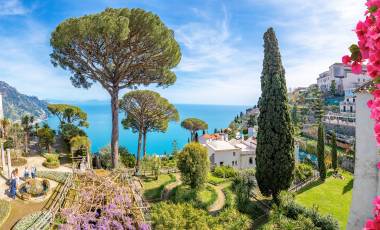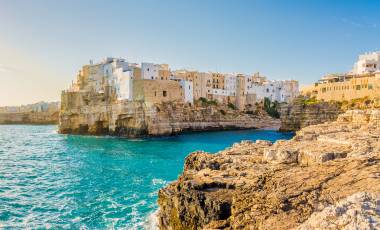Travel to southern Italy and many delights await you. The stunning, sun-soaked Mediterranean scenery of the Amalfi Coast and the Sorrento Peninsula entices visitors searching for romantic breaks away and picturesque walks along its coastline. History-lovers are equally satiated, as the area is rich with fascinating treasures. On our Highlights of the Amalfi Coast trip, we visit the legendary Pompeii and Herculaneum; places frozen in time after the eruption of Vesuvius. And what makes these two Unesco World Heritage Sites even more fascinating is that the excavations are ongoing, meaning archaeologists are still uncovering new treasures that give more insight into what life was like before the eruption. Below, we share more about the history of these remarkable places.

The eruption of Mount Vesuvius in AD 79
In AD 79, one of the most famous volcano eruptions in the world occurred at Mount Vesuvius. Devasting the surrounding area, it is thought to have killed more than 30,000 people. Although Mount Vesuvius has experienced eight major eruptions over the last 17,000 years, this one left a lasting impression due to the way the hot ash formed casts around everything in its midst, perfectly preserving the fine details of its victims and their belongings. A catastrophic event of human tragedy has therefore led to one of the greatest insights into ancient history that has ever been uncovered.

The rapid destruction of Pompeii and Herculaneum
Pompeii and Herculaneum were the two cities destroyed by the eruption of Mount Vesuvius in AD 79. The effects were rapid. It is estimated that the whole city of Pompeii was destroyed in about 25 hours.
Pompeii and its surrounding area were no stranger to seismic activity. The city was only starting to recover from a major earthquake that had occurred beneath Mount Vesuvius in AD 62. As the rebuild was taking place, further minor tremors were experienced. This may explain why the residents seemed to take little notice when warning signs of the eruption of AD 79 began.
As the massive debris cloud grew in the sky on the 24th of August, blocking the sunlight by 1 pm and raining down heavy ash onto rooftops, instead of fleeing, the residents worked furiously to clear the soot. By midnight, the wave of volcanic mud had consumed Herculaneum. Those managing to escape to Pompeii were soon caught, as by 6.30 am the volcanic gases, burning the air, had smothered their refuge, instantly killing its victims in its path. Quickly buried beneath the ash, the city and all of its belongings would remain untouched for hundreds of years.

The fascinating excavations begin
Uncovering the remains of what was effectively two buried cities was a task of epic proportions. Early excavation started in 1594 and again in 1748. However, neither attempts were particularly scientific or systematic. In 1860, an Italian archaeologist, Giuseppe Fiorelli, took over the work and a more modern approach was then taken with all findings clearly documented.

Visiting the sites today
The archaeological ruins of Pompeii cover between 64 to 67 hectares. The excavated highlights of a whole city, once buried in ash, include Roman temples, baths, a forum, an amphitheatre and villas. You could easily spend days exploring the site. Herculaneum is smaller, but better preserved, as it was covered in a protective layer of mud and volcanic ash. Visit here and you will see more vivid mosaics and frescoes and better-preserved wooden structures.
Aside from the amphitheatre of Pompeii being the earliest known stone amphitheatre in Italy, and in the rest of the Roman world, it has also been used for modern-day concerts and other public events. One of the most famous concerts held here was arguably when Pink Floyd graced the stage in 1971. Over 50 years later, Floyd drummer, Nick Mason, returned with his band Saucerful of Secrets to play in Pompeii once again at the open-air theatre, Teatro Grande nearby in July of this year.
So there you have it. A visit to Pompeii or Herculaneum is an experience like no other; take a step back in time and walk amongst a city that was stopped in its tracks nearly two thousand years ago. Our Highlights of the Amalfi Coast trip allows you to explore these treasures in-depth. To find out more about this trip, click here.







